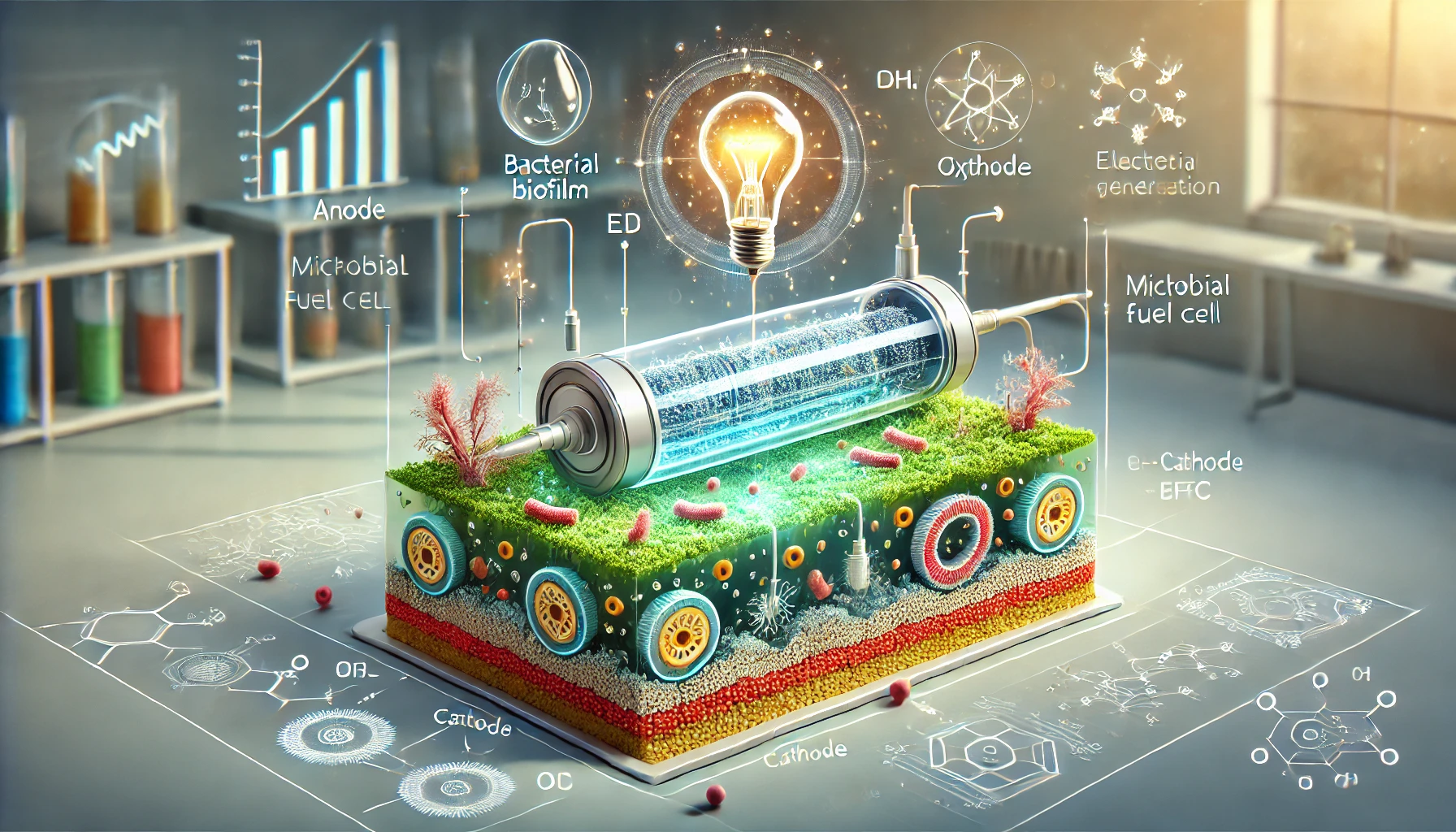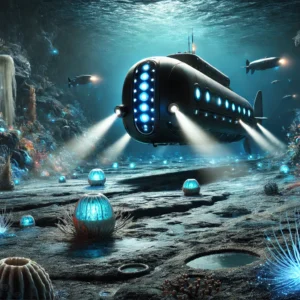
(Harnessing bacteria to generate clean electricity)
Have you ever paused at a sidewalk café, sipping your latte and daydreaming about how amazing it would be if we could somehow turn the leftover coffee grounds, or even the smallest bits of household waste, into electricity? It sounds zany, but recent breakthroughs in Microbial Fuel Cells (MFCs) are bringing us closer to that eco-friendly dream than you might imagine. In fact, what once seemed like a sci-fi fantasy—bacteria-based power—now stands at the forefront of groundbreaking green energy research.
A Quirky Glimpse into Bacterial Power
Sometimes I recall my grandmother scolding me for not finishing my meal, muttering, “Waste is the enemy of progress!” Her words echo even more today when I see scientists capturing the astonishing potential of microorganisms in a device that transforms organic waste into electricity. If only Grandma had known! Current advancements show these tiny microorganisms, referred to by some as “bacterial powerhouses,” can convert biodegradable material—like wastewater or organic sludge—into electrons we can use.
Yet, there’s no single “aha!” moment that magically brought MFCs to the spotlight. Instead, the journey has been riddled with a bit of confusion, a dash of controversy, and a whole lot of determination from labs and institutions worldwide. Political figures and celebrities, older generations, and young activists alike are all chiming in, each with their own perspectives and, occasionally, contradictory opinions.
Understanding Microbial Fuel Cells
In plain English, Microbial Fuel Cells are bio-electrochemical devices. They leverage the natural metabolic processes of bacteria, which break down organic matter and release electrons. These electrons travel through an external circuit and generate power. Think of it as an organic battery that can run on everything from wastewater to organic byproducts from industries.
Engineers typically construct MFCs with two compartments: an anode chamber (where bacteria reside) and a cathode chamber. Between these two chambers, a membrane or similar separator allows ion exchange. As the microorganisms eat their “food” in the anode chamber, electrons move toward the cathode, thus creating an electrical current.
For an in-depth scientific dive, you might enjoy the details from a 2023 research paper on microbial fuel cell performance improvements. They’re experimenting with new electrode materials, from carbon nanotubes to manganese oxide structures, all in an effort to boost efficiency, cut production costs, and streamline large-scale adoption.
Latest Government Notes and Policies
You might be surprised to learn that government entities worldwide have begun looking seriously at MFCs as part of future energy strategies. In the United States, preliminary funding programs under the Department of Energy are backing labs that explore scalable MFC designs. While these initiatives are still in the pilot phase, the buzz within policy circles is that MFC research could eventually become an integral component in a larger tapestry of clean energy solutions.
Across the pond, the European Union is drafting pilot directives incentivizing waste-to-energy conversion programs, explicitly naming microbial systems. Politically, these moves stem from a growing demand to align with the Paris Agreement’s decarbonization goals. By leveraging MFC technology, governments hope to simultaneously tackle waste management and greenhouse gas reduction.
Still, not everyone’s in perfect alignment. A handful of policymakers argue MFC tech is “just too experimental,” or the cost of large-scale deployment might outweigh immediate benefits. Yet, the mood in many legislative meetings has been quite hopeful—and, in some cases, urgent. Even in the midst of budget constraints, green energy funding rarely sees the chopping block, signaling bipartisan support for continuing research into MFCs and other future-focused renewable solutions.
Political News and Debates Around MFCs
One quirky story circulating in 2025 political circles: a local council in a mid-sized European city recently decided to power streetlights using small MFC prototypes fed by city wastewater. A member of a rival political party allegedly claimed it was “another attempt to flush taxpayer money down the drain,” quite literally. But guess what—early results show moderate success. Though it’s not yet reliable to power the entire street, the partial usage has sparked huge curiosity.
In national headlines, a few governments are including MFCs in their strategic energy roadmaps. For instance, the Indian Parliament briefly discussed adding MFC pilot plants in rural communities to power basic utilities. Meanwhile, in countries like South Korea, politicians are exploring synergy between MFC-based wastewater treatment and hydrogen production—a futuristic twist that merges two emerging green energy avenues.
So, are these developments foolproof? Of course not. Political journeys rarely follow a straight path, especially where new technologies are concerned. There are times when misunderstandings, or even political grandstanding, overshadow the real scientific promise. But every debate fosters public awareness, helping MFCs inch closer to mainstream recognition.
Research Labs and Pioneering Scientists
If you imagine a group of white-coated laboratory scientists vigorously peering into flasks of bubbling bacteria—well, you’re not too far off. But the real scene is often more chaotic, with half-finished experiments cluttering tables, and the occasional comedic mishap of someone mixing up electrodes.
- California Bioenergy Institute (USA): Recently published results suggesting a specialized bacterial strain that thrives in high-salinity conditions, potentially useful for coastal wastewater treatment. They credit cross-collaborations with local desalination plants for advanced prototypes.
- European Green Tech Lab (Germany): Focused on electrode material innovation—incorporating 3D-printed graphene to improve current density. They’re working closely with local automotive giants to adapt MFC prototypes for hydrogen production.
- National Center for Biotechnology (India): Investigating how indigenous bacterial cultures can be harnessed to treat municipal sludge. Their approach, as per a recent publication, might bring down operational costs.
In some rather upbeat news, an international team of researchers from Brazil, Japan, and South Africa is collaborating on a robust MFC design specifically for developing regions. They want to address electricity shortages in communities that have abundant organic waste (like crop remnants), but limited finances. These cross-continental projects are stirring up excitement in the global scientific sphere.
Celebrity Endorsements and Inspiring Words
Strange to think, but we live in a time when A-list celebrities champion green causes with nearly as much fervor as they do their film careers. Actor and environmental activist Leonardo DiCaprio has spoken in interviews about the potential of MFCs, calling them “the next wave in sustainable innovation.” Meanwhile, musician and philanthropist Pharrell Williams teased a collaboration with environmental engineers to explore the synergy between biodegradable plastics, bacteria, and power generation.
While some might roll their eyes, calling these endorsements a fleeting trend, the truth is celebrity words help raise mainstream awareness faster than any academic journal. The pop-culture push, combined with scientific progress, shapes a narrative that resonates with youth activists and older environmental stewards alike.
Voices of the Older Generation
“Honestly, I never thought I’d see the day when bacteria could run a toaster,” chuckled an 82-year-old retiree I interviewed at a local senior center. Many older folks find the concept of MFCs fascinating but sometimes grapple with the complicated jargon. There’s a sense of cautious optimism: “If it helps my grandchildren breathe cleaner air,” another grandparent said, “I’m all for it. Just don’t break the bank trying to fix something we can handle with simpler methods.”
Skepticism occasionally emerges, often tied to financial concerns or trust in new scientific developments. Some older citizens prefer proven technologies like solar and wind, though many show interest once they learn that MFCs could reduce the burden of waste management. Ultimately, bridging the gap means clearer explanations and showing tangible benefits on small scales—like a community-based pilot project or even a small demonstration in a local school.
The Youth Perspective and Green Aspirations
On the other hand, younger activists, teenagers, and university students brim with excitement about MFCs. For Gen Z, anything that addresses climate change, pollution, and ecological footprints is an automatic attention-grabber. High school science clubs are dabbling with do-it-yourself MFC kits, demonstrating how fruit waste or leftover cafeteria scraps can spark a little LED light. The delight in seeing food waste lit up is beyond measure.
Many see MFCs as not just a technology but a movement—a tangible proof that sustainable solutions can be creative, sometimes odd, but always forward-thinking. There’s an undeniable enthusiasm among the youth for merging biology, chemistry, and engineering in ways that could ultimately shape the planet’s future. This grassroots passion translates into social media campaigns, crowdfunding for small lab projects, and a wave of hackathon events exploring better MFC designs.
Global Business and Revenue Opportunities
When entrepreneurs hear about any feasible green tech, their mental calculators start churning. MFCs, if advanced to a commercial scale, have multiple revenue angles.
- Waste Management: Industries generating huge amounts of biodegradable waste can potentially use MFCs for on-site electricity generation. A 2024 research article on alternative energy sources highlights how breweries, dairy farms, or fruit-processing plants could convert leftover biomass into some portion of their electricity demands, thereby cutting disposal costs.
- Water Treatment Plants: Traditional treatment processes are resource-intensive. Integrating MFCs could simultaneously purify water and generate electricity. This synergy appeals to regions struggling with energy deficits.
- Agricultural Sectors: Large-scale farms or rural cooperatives might harness MFC-based systems to process manure or crop residue. The electricity produced could power irrigation pumps or chilling units for dairy.
- Licensing and Patents: With universities and labs patenting novel MFC components (like improved membranes or electrode materials), licensing deals are slowly surfacing. A rising wave of startups is now forming strategic partnerships with bigger corporations, eyeing expansions that could bring in revenue streams reminiscent of solar panel success stories.
Estimates for global MFC market growth vary, but some projections anticipate a multi-billion-dollar valuation by the early 2030s. At a 2025 economic forum, a technology investor exclaimed, “Get in on MFC technology now, or watch from the sidelines as the next big green wave sweeps over!” A tad dramatic, maybe, but it points to the building momentum.
Societal and Cultural Shifts
Every new technology stirs debates in society—MFCs are no exception. The idea that “bacteria” might power your house can evoke images of uncleanliness or fear in some corners. Education becomes key here. Once people realize the bacteria in MFCs are contained in a well-designed system, their misconceptions fade.
In certain cultural contexts, the acceptance of bacteria-based solutions is also tied to local beliefs. Some communities find it thrilling that nature and science merge in a holistic cycle: we feed the microorganisms the waste, and in turn, they provide the energy. It resonates with the cyclical philosophy of many indigenous cultures that see all living things as interconnected.
As MFCs gain traction, you might see subtle changes in how consumers view waste. There is excitement in a future where landfills decrease in size, replaced by “power plants” that thrive on biodegradable trash. Imagine rummaging through your leftovers with less guilt, knowing they might eventually produce clean power.
Technological Progress and Awkward Hurdles
Despite the optimism, MFC technology is still evolving. Power densities, or the amount of electricity generated per unit area of the electrode, remain somewhat low compared to conventional sources like solar or wind. From recent analyses to older but foundational studies, scientists emphasize the challenge of finding cost-effective materials that enhance electron transfer.
- Membrane Upgrades: Many MFCs rely on proton exchange membranes (PEMs), but these can be expensive or degrade over time, especially in wastewater conditions.
- Biofilm Management: The bacterial communities, or biofilms, can be finicky. Maintaining consistent performance may require specialized knowledge of microbiology.
- Scale-Up Challenges: Demonstration projects look promising, but bridging that gap from small pilot units to industrial-scale facilities is full of engineering complexities—piping, contamination control, and variable organic load.
Let’s not forget the occasionally unexpected results: a lab might see a sudden drop in electricity because the bacteria decided they didn’t fancy the new substrate. Or a pilot project might fail because the microbial culture wasn’t robust enough for real-world waste. Such hiccups, though frustrating, pave the way for new experiments and often surprising solutions.
Are MFCs the Sole Future of Green Energy?
In a word: No. However, Microbial Fuel Cells represent one puzzle piece in a broad mosaic of renewable energy solutions. Solar power, wind turbines, hydropower, geothermal systems, and hydrogen fuel cells are all vital to a balanced energy portfolio. The real beauty is how MFCs can potentially complement these existing sources—particularly in waste-heavy sectors or regions with limited grid infrastructure.
One emerging trend is hybrid systems. For instance, pairing an MFC-based wastewater treatment approach with a solar farm can ensure constant electricity generation (the MFC works steadily, albeit at a low capacity, while solar covers peak needs). This synergy might make sense in rural or remote areas. The year 2024 saw the publication of multiple papers on complementary hybrid designs that incorporate MFCs with other renewables (Source).
Real-World Applications and Anecdotes
I recently visited a small research station experimenting with MFCs to power sensors that monitor water quality in marshlands. The lead scientist told me how the concept was simple enough on paper, but an ill-timed swarm of insects messed up their experimental setup. The bacteria eventually recovered, and after some creative tinkering, the sensors functioned for weeks without external batteries.
Likewise, an industrial-scale pilot program in Asia uses MFC technology to treat aquaculture wastewater. The system not only reduces chemical oxygen demand (COD) but also produces a modest amount of energy that offsets parts of the facility’s operational costs. While the kilowatt output remains modest, it demonstrates a promising route for farms and processing plants wanting to trim their carbon footprints.
Navigating Social and Political Complexities
MFCs, like most green tech solutions, can’t be viewed in a vacuum. We have to consider the social context—who pays for it, who benefits, and whether it addresses or amplifies socio-economic disparities. Some critics argue that advanced MFC systems might primarily benefit wealthier companies able to invest in research, leaving smaller communities behind.
This is why many governments emphasize public-private partnerships and pilot projects that cater to both industrial players and underfunded localities. Politically, no one wants to see a technology so promising remain accessible only to the elite. Advocacy groups, youth activists, and scientists push for open-source designs, training programs, and government subsidies.
Meanwhile, a handful of critics raise concerns about overhyping the technology. They stress the importance of continuing robust research to confirm MFCs’ long-term viability before rolling out massive infrastructure changes. Even so, the general consensus is that such caution, while prudent, shouldn’t diminish the potential MFCs hold for forging a greener energy future.
Possible Revenue Models for a Green-Era Future
As we hurtle toward a future that demands sustainable infrastructure, corporations and startups are brainstorming how to monetize MFC-based systems:
- Energy-as-a-Service (EaaS): Companies install MFCs on client premises, handle all maintenance, and sell electricity at a set tariff.
- Waste-to-Power Contracts: Municipalities or private waste management firms pay a service fee to convert organic garbage into electricity or purified water, reducing landfill usage.
- Patent Royalties: Universities or research labs with proprietary electrode materials or unique bacterial strains license their breakthroughs to industrial partners.
- Carbon Credits: MFC deployments may qualify for carbon offset credits in regions with cap-and-trade policies, providing another revenue source.
At a global business conference last year, an executive from a major agricultural equipment firm predicted that MFCs could spark new forms of local entrepreneurship. Farmers, for instance, could transform their livestock waste or crop residue into electricity, then sell surplus power or feed into microgrids.
Balancing Hope with Reality
These glimpses into the MFC landscape paint a picture of both thrilling possibilities and sobering technical limitations. The technology is still in flux. However, with each passing month in 2025, new research reveals ways to enhance performance, reduce costs, and optimize the bacterial consortia.
Some experts are optimistic that, within a decade, we might see smaller-scale MFC systems become household appliances—especially in rural or off-grid settings. Others argue the real sweet spot is in industrial or municipal-scale projects where the volume of organic waste is high, providing a continuous feedstock for electricity production.
Even if MFCs never surpass solar or wind in total energy capacity, they hold a valuable niche: turning the daily nuisance of waste into a partial solution for an ever-growing energy demand. There’s an inexplicable satisfaction in that closed-loop concept—the cycle of trash turning into treasure.
Mildly Awkward Yet Refreshing Tangent
Now, let me slip in a random anecdote that might feel a bit out of place: a friend of mine once thought “microbial” was a new brand of cereal. She grimaced when I explained it’s basically “bacteria.” Perhaps that’s a good reminder that not everyone is in the loop about these futuristic trends. Our first step is bridging the knowledge gap—just as we want MFCs to bridge the gap between waste and clean energy.
Wrapping Up and Looking Forward
As we circle back to the original question—could we really live in a future where our lunch leftovers power our homes? We’re inching closer. Beyond the science and the scurrying of research labs, we see endorsements from celebrities, supportive government notes, serious discussions in political forums, and potential large-scale applications that might make a tangible impact.
Microbial Fuel Cells are no silver bullet; if there’s one thing I’ve learned from both personal daydreams and serious lab visits, it’s that a multi-pronged approach is key to sustainable energy. Still, MFCs speak to our collective desire for practical, creative, and inclusive solutions to the climate crisis.
Older generations, once skeptical, are warming up to the idea if it means a healthier planet for their grandchildren. Young activists are championing MFC adoption in schools and communities. Business leaders foresee commercial advantages, while scientists keep refining the nuts and bolts of bacterial electrochemistry.
Maybe you’ll get to watch, in real time, as these microscopic ecosystems hum to life and do the unthinkable: turn garbage into electricity. Don’t you think that’s an exciting possibility—one that might become as normal as flipping on a light switch in the very near future?
Call-to-Action: Join the Bacterial Revolution!
- Feeling inspired? Share this article on social media or with your local representatives to spark conversations about Microbial Fuel Cells and what they could mean for your community.
- Consider signing up for our newsletter, where we provide monthly updates on new research, pilot programs, and ways you can get involved in the green energy revolution.
Frequently Asked Questions (FAQs)
- Are Microbial Fuel Cells safe for daily use?
Yes, MFCs are generally safe. The bacteria remain enclosed within the system, and the process typically involves minimal risk when engineered properly. - Can MFCs fully replace solar or wind energy?
Probably not. MFCs work best when integrated with other renewable sources. They’re especially suited for waste-rich environments. - How expensive is MFC technology right now?
Costs vary. Research labs are experimenting with cheaper materials to make MFCs more accessible, and new government subsidies could accelerate adoption. - Is the electricity generated by bacteria stable?
It can be steady at smaller scales, but large-scale reliability depends on effective system design and consistent organic feedstock. - Where can I learn more?
Check reputable sources like National Center for Biotechnology Information (PMC), ScienceDirect, and ACS Publications for the latest peer-reviewed studies.





